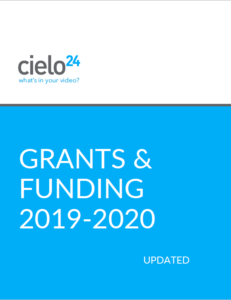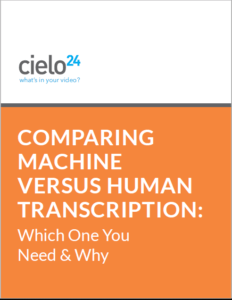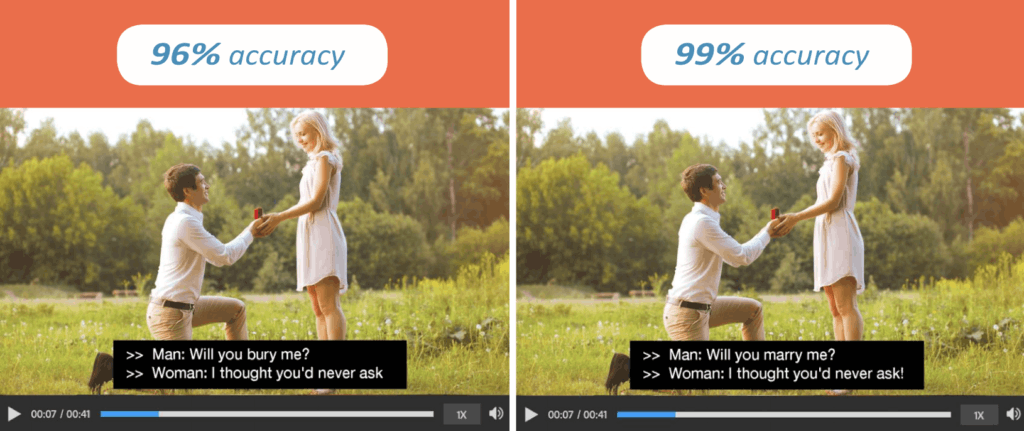Creating and using Amazon video captioning is a technical process that might be challenging for…

Using Grants to Fund Your Video Library and Captioning Strategy
Not many people think about using grants to fund their video library and captioning strategy, but you should. If you work in a field that employs a lot of video development but are not able to find the money to properly manage or caption those videos, you are left in quite the quandary. The challenge only intensifies if you are required to provide video accessibility by law and/or inclusive design on top of your many other media demands.
- You have a ton of video content.
- You have to make that content accessible to everyone.
- You have to organize and catalog that content.
- You have no room in your budget.
What’s the answer to your conundrum? Well, one option is applying for grants and government funding – of which there are numerous opportunities available that can provide the money needed to invest in the right video captioning and data management solution.

Using Grants to Find Funding for Your Video Library and Captioning Strategy
A lot of organizations are turning to available grants and federal funding to create a makeshift video captioning and data management budget.
When it comes to applying for grants, it’s important to first understand the three primary stages of the grant application process:
- Pre-award stage
- Award stage
- Post-award stage

The pre-award phase is when you will seek and find grants that fit your needs and parameters that you’re actually eligible for. You then learn how to apply for grants through their specific applications and begin the formal grant process. The pre-award stage is critical.
It’s also extremely important to know where to look for grants and funding. Some general resources include federal agencies, state agencies, and private organizations (you can search by type). We have an ebook that includes a number of available grants open right now and a resource on the way outlining available state grants.
Learn in-depth on how to find and properly apply for the right grants.
The truth is that there are a lot of great grants and federal funding opportunities out there, and fewer people who actually take the time to apply – likely thinking they’ll never win. But if you learn the process and make grant application a part of your overall budget, you will (almost guaranteed) win some funding.
What You Need to Know about Free Captioning Solutions

One route companies will take is to use YouTube or other platforms that offer free machine transcription and captioning to manage their videos. The appeal of YouTube is understandable – it offers a comprehensive, organizable video library and they caption video content for free.
Voila! Perfect solution. Not so much.
YouTube captions are highly inaccurate, and they also don’t offer a text-based copy of your video transcription, all which lead to a multitude of issues:
- No ownership over your video library management.
Your videos live on YouTube, not your own network. YouTube can change its platform rules and requirements at any time. For example, YouTube recently changed their monetization rules in 2018, setting eligibility for the Partner Program, a collective whose channels can be monetized through Google AdSense, at a total watch time of 4,000 hours in the previous year and a minimum of 1,000 subscribers. Whether or not you’re using YouTube to monetize your videos, the point is that YouTube was able to make this decision without their user’s consent, completely changing the business model for thousands of video-based companies.
- No say in which advertisements are connected to your videos.
Similar to not owning the managerial operations, putting your videos on YouTube means you agree to an advertisement being placed in connection to your video – either before, during or after the video runtime – without any control over the ad content. This can become problematic when, say, a child-targeted video is connected to an advertisement for a vape pen cigarette.
- Poor brand management.
This leads directly into the next concern, which is being unable to properly manage your brand perception through YouTube. Think of it this way – poor audio captions that can completely misconstrue your message followed by inappropriate advertisements. This can leave people with a poor opinion of your company as a whole, all due to issues beyond your control.
- No text-based transcript of your video content – aka no boost to SEO.
Search engines cannot crawl video content to then rank and index them. This means that all video content fails to provide an impact to your SEO unless you embed the text-based transcript into your HTML. Since YouTube doesn’t provide the transcript of your video, you can’t apply that information to your website unless you manually transcribe the videos yourself. This can lead to a harmful captioning strategy if human oversight is not applied to machine transcripts for SEO value.
- No rich media data.
Finally, at cielo24 we not only provide a full, highly accurate video transcript, but we also provide other rich media data that is extremely useful towards business growth and operational improvements. This includes speaker identification (great for presentation analysis and improvement), critical subjects and topics that may be overlooked, keywords used for website optimization, and more.
When to Use Grant Funds for Human Captioning
Human transcriptions are much more accurate. For accessibility compliance requirements, human-based verification is necessary to meet the 99% accuracy threshold. Especially if the recording or video file is of lower quality, machines have a difficult time making out every nuance of tone, dialect, or jargon.
Human transcriptionists can also provide speaker identification, perform foreign language translations, and include descriptive explanations that go beyond speech-to-text alone.
And with improved accuracy comes improved SEO, search ranking and content engagement. You should incorporate a human captioning strategy if:
- If you are federally required to have accurate captions
- Need or want accuracy for improved brand perception
- Have more money to invest
- Don’t have time to spend on editing your own content
- Want to formally publish your work
- Want to significantly boost your SEO
- Have low-quality recording
- Have a recording with foreign languages that need translating
- Have a recording with heavy accents, dialect or jargon that needs identifying
- Have multiple speakers that need identifying
- Have contextual elements beyond speech-to-text that need identifying

Both machine transcription and human transcription hold a valuable place in the world of online captioning and transcribing. It’s helpful to understand the differences to make an informed investment as you work to optimize your content.
Using Your Funded Budget Towards Captions, Transcripts, and Video Management
 One option is to sign up for Self Serve web app, which allows you to get started on transcriptions and captions immediately without the wait for contracts or quotes. Self Serve gives you a free caption and transcript, and then human-verified transcriptions and captions start at less than $1/minute.
One option is to sign up for Self Serve web app, which allows you to get started on transcriptions and captions immediately without the wait for contracts or quotes. Self Serve gives you a free caption and transcript, and then human-verified transcriptions and captions start at less than $1/minute.
Another option – especially if you know you have a large video library to manage – our Enterprise plans that are built around your specific needs. These accounts come with the help of an account executive to help satisfy more complex and/or larger amounts of media that need captioning or transcription. Through Enterprise you also have access to our full suite of video and audio data solutions – like 16+ foreign language translations, advanced media data, and our video wrapper. Most companies that face federal captioning requirements use the Enterprise level account in order to ensure all the ADA compliance requirements are being fully met. However, the choice is always yours! And the options are there for your personal selection.
For more information on our video transcription accuracy, captioning and video intelligence solutions, contact us online or call us at 1-855-243-5624.
cielo24 is removing barriers to increase video marketing ROI, searchability and compliance for all your videos!



